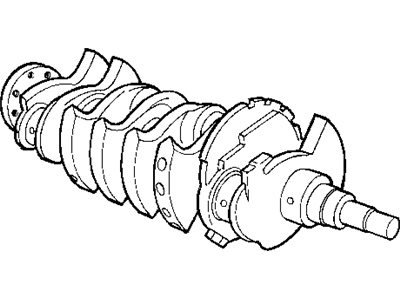
My Garage
My Account
Cart
Genuine Chrysler Cirrus Crankshaft
Crank Shaft- Select Vehicle by Model
- Select Vehicle by VIN
Select Vehicle by Model
orMake
Model
Year
Select Vehicle by VIN
For the most accurate results, select vehicle by your VIN (Vehicle Identification Number).
1 Crankshaft found
Chrysler Cirrus Crankshaft
Looking for affordable and high-quality auto parts? Then you have already arrived at the proper online shop. We offer all Chrysler Cirrus Crankshaft at great affordable prices. Moreover, all genuine Chrysler Cirrus Crankshaft come with a manufacturer's warranty. In the long run, you would realize you have saved a lot of trouble and money with OEM parts from here.
Chrysler Cirrus Crankshaft Parts Questions & Experts Answers
- Q: How can the crankshaft be removed from the engine after it has been taken out on Chrysler Cirrus?A:The crankshaft can only be removed after the engine has been taken out of the vehicle, assuming that the driveplate, crankshaft pulley, timing belt, oil pan, oil pump body, oil filter, and piston/connecting rod assemblies have already been detached. For V6 engines, the rear main oil seal retainer must be unbolted and separated from the block prior to crankshaft removal. First, measure the endplay by mounting a dial indicator aligned with the crankshaft and touching its end. Pry the crankshaft to the rear and zero the dial indicator, then pry it to the front and check the reading; the distance traveled indicates the endplay. If it exceeds the tolerance, inspect the crankshaft thrust surfaces for wear after removal, and if no wear is found, new main bearings should resolve the endplay issue. If a dial indicator is unavailable, feeler gauges can be used by prying the crankshaft to the front and inserting the gauges between the crankshaft and the thrust bearing or washer to measure clearance. Next, loosen the main bearing cap assembly bolts a quarter turn at a time until they can be removed by hand. Gently tap the main bearing cap assembly with a soft-face hammer around its perimeter and pull it straight up off the cylinder block. For 2.0L four-cylinder engines, remove the oil filter passage O-ring seal and the three main bearing cap assembly locating dowels, taking care not to drop the bearing inserts if they come out with the assembly. Finally, carefully lift the crankshaft out of the engine, ideally with assistance due to its weight and awkwardness. With the bearing inserts in place inside the engine block and main bearing caps, reinstall the main bearing cap assembly onto the engine block and tighten the bolts finger tight, ensuring that on V6 models, the assembly is installed with the arrow facing the front (timing belt end) of the engine.












